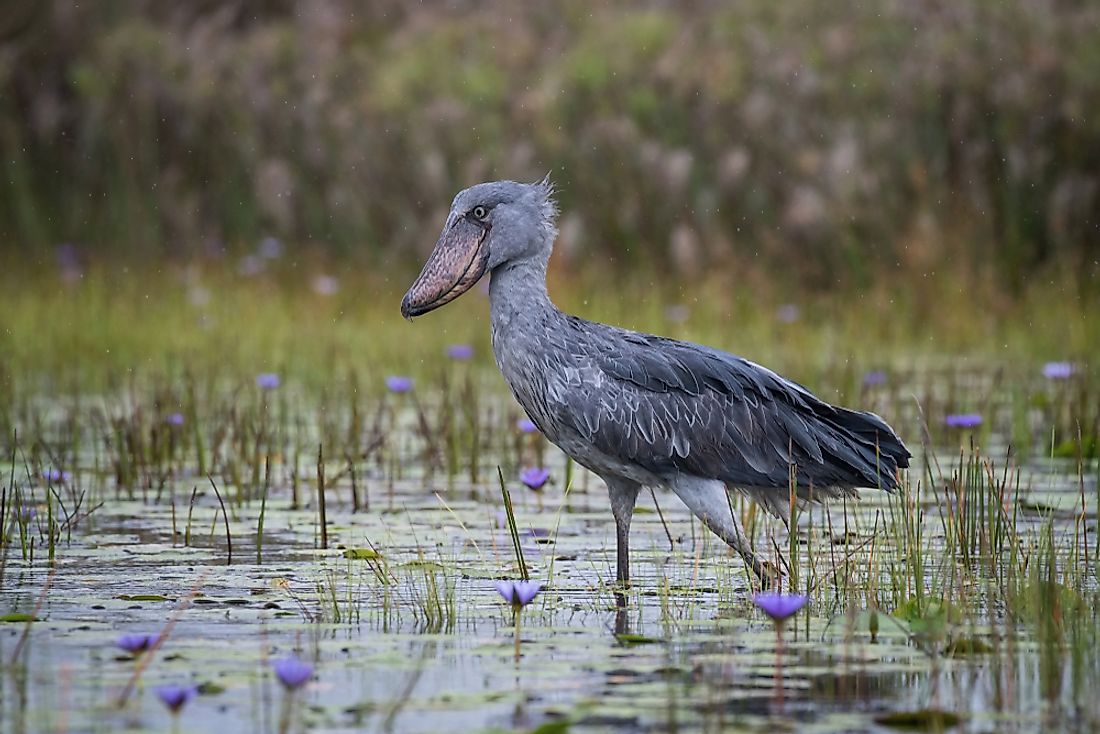Shoebill Facts - Animals of Africa

Shoebill (Balaeniceps rex), is also known as Shoe-billed stork or Whale head. The bird earned its name as it has Shoe shaped Bill. The shoebill is found in freshwater swamps and marches in eastern-central Africa.
Size and Appearance
The bird is large and tall, ranging from 110 cm to 140 cm in height. However, some species grow as tall as 152 cm. The shoebill’s weight ranges from 4 kg to 7 kg, whereby, females weigh 4.9 kg while males weigh 5.6 kg. Its length from the beak to the tail is between 100 cm to 140 cm. Furthermore, the shoebill has a remarkable bulbous and huge bill with grey spots and straw in color. Its neck is relatively thick and shorter than other wading birds like cranes and herons. It also has wide wings adapted for soaring.
Habitat and Distribution
The Shoebills dwell mostly in marshy fresh waters. Wetlands with reed beds, Typha and Cyperus Papyrus attract these species. However, shoebill distribution depends on distribution of papyrus in Central Africa but they also tend to avoid swamps with pure papyrus. They are mostly attracted to mixed vegetation areas. Scarcely, these species have been spotted feeding in rice fields and other flooded plantations.
The Shoebills thrive in Southern Sudan fresh water swamps, Congo, Uganda, and Central tropical of Africa among other countries. They are more in West Nile and borders of South Sudan. The wetlands of Western Tanzania and Uganda also, record a significant number. Few Shoebills inhabit Malawi, Kenya, and North Cameroon. Shoebills do not migrate but minimal movements have been seen due to human disturbance, change in habitat, and lack of food. Reports further reveal that shoebill distribution coincides with that of Lungfish and Papyrus.
Behavior
Shoebill is popular for its tendency to remain for a long time. The bird also has slow movements. This has earned the species the name, ‘’Statue-like’’. Because of their high sensitivity to people disturbance, shoebills can evacuate their nests if disturbed.
Diet
Shoebills feed on fish and floating water vegetation. This is the reason as to why they are attracted to waters with less oxygen where fish surface in order to breath. Muddy waters, also makes a suitable environment for shoebill feeding. Shoebills do not have tactics to hunt but they use their entire vision. They do so by launching a violent and quick attack. However, Hippos activities can also benefit shoebills as they normally force fish to surface while moving under water. Shoebills prey on Tilapia, Catfish, Marbled Lungfish, and Senegal Bichir among others. Other animal species eaten by Shoebill include; Nile Monitors, frogs, young crocodiles, and water snakes. On the other hand, the shoebill may feed on snails, turtles and rodents.
Shoebill Conservation and Status
Shoebills population ranges from 5,000 to 8,000 with majority in Congo, Sudan and Uganda. Bird Life International has classified them as vulnerable species. Shoebills face major disturbance and hunting from human. This has greatly affected their population in the continent. Habitat destruction by fires and logging has also negatively affected the Shoebills’ wellbeing. The Shoebill is among the top five birds loved by ornithologists in Africa. There are shoebill statues in Egypt. Among Arabs, the shoebill is known as "abu markub" meaning one with a shoe.
Reproduction
Due to their solitary nature, shoebills’ build their nests far apart. Unlike other birds that nest in colonies, typical Shoebill's nests occur at less than three nests per square kilometer. Two shoebills, male and female, pairs up to breed and zealously guard their territory. Mainly, nesting occurs at the end of the wet periods. Both parents are actively involved in building the nest. While preparing to nest, shoebills clear approximately an area of 3 meters. Often, shoebills only raise one chick though they may hatch more. Shoebills take approximately three years before attaining sexual maturity.











